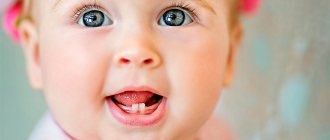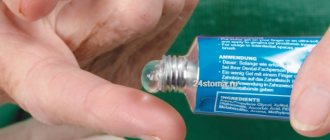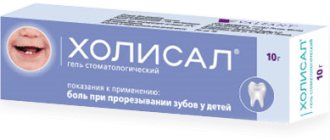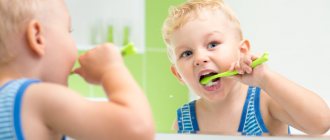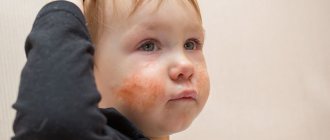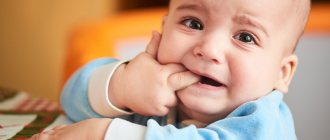In the first years of life, a child’s milk teeth erupt, he gradually begins to eat food familiar to adults, and a chewing reflex is formed. During this period, it is important to choose the right hygiene products so that the child has healthy and strong teeth in the future.
Today we will tell you how to choose your first brush and paste, prevent the development of caries in the early stages without going to the dentist, and also get through the eruption of baby teeth.
- Where do babies get caries?
- Hygiene products for the first 6 months
- What should the first brush be?
- What kind of pasta should a child under 3 years have?
- How to cure tooth decay without a dentist
- When to wean off a pacifier to avoid problems with bite
- Rules for oral care up to 3 years
- Tips from a pediatric dentist: video
Where do babies get caries?
Local immunity in the child’s oral cavity develops gradually; the first bacteria are transmitted from the mother at birth and during feeding. Initially, the oral cavity is sterile, and the microflora is formed when contacts with the outside world occur: parents lick a pacifier or bottle, try complementary feeding with a baby spoon, kiss the child.
During these contacts, bacteria are transmitted to which the immune system adapts, but it can fail due to sudden changes or illness. Transmission of harmful bacteria most often occurs at an early age through the so-called “window of infection,” but it is also possible at earlier or later periods.
The child’s microflora is not yet ready and cannot cope with many infections: thrush or stomatitis fungus, streptococci and staphylococci (provoke the development of sore throat), as well as E. coli and the herpes virus.
One of the latest studies states that the most commonly transmitted infection is Streptococcus mutans. It is this that provokes the development of caries. Moreover, it is transmitted even if the parent does not have carious teeth, since the adult’s body is more prepared to cope with viruses and infections - cariogenic bacteria do not have time to form caries in the enamel. But the baby’s body is just learning, and the baby’s risk of developing caries is higher because of this. Therefore, dentists recommend limiting contact: various licks and kisses.
The main sources of transmission of cariogenic bacteria in a child under 3 years of age: tasting food during complementary feeding, licking pacifiers, bottles and toys, kissing
Scheme for using gels during teething -
During teething, gels are applied to the gums 3-4 times a day (plus additionally before bedtime) - using a finger or a cotton swab, after which you rub the gel into the gums with gentle massaging movements. The gel will rub in better if you first dry the moist mucous membrane at the site where the gel is applied - using a dry gauze swab or sponge (otherwise the gel will slip off and be swallowed).
An important point is that the treatment of gums with gels should be carried out not before meals, but after meals and oral hygiene. In infants (especially if the treatment is carried out before the child goes to bed), it is advisable not to use gels with the anesthetic Lidocaine - to avoid swallowing problems and choking with saliva. Also, you should not use drugs that have a strong, pronounced taste (such as Cholisal gel), which will already increase the production of saliva in the child.
Also, if necessary, you can combine the use of a gel for topical use in the oral cavity with systemic drugs. These can be – 1) homeopathic medicines in dragees such as “Dantinorm Baby” or “Dentokind”, 2) a convenient form in the form of suppositories for the drug “Viburkol”. Starting from 3 months, with severe pain and/or temperature during teething, Panadol and Nurofen can also be used. Read about the effectiveness of systemic drugs at the link below.
→ Drugs for teething in children
Hygiene products for the first 6 months
It usually takes 6–10 months before the first teeth appear. Oral hygiene at this time is just as important as after teething, since it affects the formation of strong local immunity and the bite of teeth in the future. Note that during this period, parents should pay attention to three things in their baby’s oral care arsenal: the right pacifiers, cleaning wipes with xylitol, and a gel to facilitate teething.
Orthodontic nipples
If you use pacifiers, firstly, they must be orthodontic, and secondly, do so before 6 months, when the first teeth begin to cut. After 6 months, the pacifier may affect future bite formation.
Removal of pacifiers until 8-9 months of age forms the correct bite and helps the development of the jaw. According to studies of dental anomalies, more than half of the complaints about malocclusion are received during the period of early mixed dentition (6–9 years), but the formation of the position of the teeth begins in infancy. Parents of children participating in the study indicated that the upper incisors were tilted due to the bad habit of sucking pacifiers and fingers.
In addition, it is at this age that the sucking reflex is replaced by a chewing one, so it will be psychologically easier for the child to wean himself off the pacifier.
Philips AVENT Ultra Air pacifier 0-6 months with a pattern (2 pcs) SCF345/20
AVENT Ultra Air night pacifier 0-6 months (2 pcs) SCF376/12
Philips AVENT Ultra Air pacifier 0-6 months (2 pcs) SCF244/20
Wipes with xylitol
Until the child has his first teeth, it is recommended to use sanitary napkins with xylitol. They help maintain normal pH levels and reduce acidity levels in the mouth. Due to the increased level of acidity in the mouth, a favorable environment is created for the proliferation of many bacteria: for example, cariogenic and thrush bacteria.
To use, wrap a napkin around your finger and clean the surface of the oral cavity: gums, tongue, teeth.
Teething gels
When teething, the child may develop a fever and begin coughing from the constant flow of saliva. To avoid mistaking these symptoms for ARVI or another disease, pay attention to the following signs.
- The gums turn red and become white in places where they erupt.
- Saliva flows profusely.
- The baby puts his hands and toys into his mouth to relieve the itching.
- The baby may throw food, does not eat enough, overeats, which can cause an upset stomach.
To make teething easier, try massaging the gums with a silicone fingertip or give your child a special teether. And if local massage does not help, try special gels. They work well with teethers and finger guards and also relieve inflammation. These gels contain only harmless components of plant origin.
Jack N Jill Silicone Finger Brush (6-12 months)
Teether brush miradent INFANT-O-BRUSH yellow
Oral gel Pierre Fabre Pansoral First teeth
Teething gel BabyDerm Teething gel, 30 ml
Baby Doctor “First teeth” gel (15ml for relieving sore gums during teething)
A country
Israel
The country of production may vary depending on the batch of goods. Please check with the operator for detailed information when confirming your order.
Compound
Tube 15ml
Water, calendula, echinacea, chamomile, plantain, marshmallow root, methylcellulose, methylparaben.
pharmachologic effect
During the teething period, children feel severe pain, which causes their sleep to be disturbed, their appetite to be lost, and they become capricious. Baby Doctor has a gentle effect on sore gums, eliminates swelling and relieves pain. As a result, the child’s mood improves and he begins to eat well. Due to the composition of herbal components, the occurrence of an allergic reaction is unlikely. The drug has a local effect on the gums and is characterized by low systemic absorption. Therefore, the medicine does not affect the functioning of the baby’s vital organs. Immediately after the first application to the gums, the drug begins to act, providing a calming effect and relieving inflammation. Pain and itching go away instantly, and the results last a long time. Thanks to marshmallow root, a protective film is formed in the sensitive area. Thanks to it, the process of healing and restoration of the mucous membrane is accelerated. The formation of a protective layer provides not only a wound-healing effect, but also ensures that the effect of the remaining components of the drug on the gums remains for some time. This is one of the few drugs that contains a minimal amount of chemicals.
Indications for use
The soothing gel was created specifically for children and is approved for use from the age of three months. The main purpose is to eliminate unpleasant symptoms when the first teeth appear. The drug consists of natural ingredients and is not considered a medicine, so there are no contraindications to its use. But it is still recommended to apply a very small amount of gel when using for the first time, in order to avoid allergic reactions and side effects.
Side effects
The instructions for the drug state that no side effects were identified when using the product, but from the reviews of parents it becomes clear that in some cases the use of Baby Doctor gel can provoke an allergic reaction, which manifests itself in the form of a small rash on the body. After discontinuation of the drug, the symptoms go away on their own. In rare cases, bowel problems in a child have been reported.
Mode of application
Before using the drug, parents should wash their hands thoroughly. Using clean fingers, apply a small amount of product to the sensitive area of the gum and rub it in with gentle, gentle movements. To carry out the procedure, you can use a cotton swab and a special silicone brush. The gel is applied as needed; there are no restrictions on the number of applications. Dr. Baby First teeth can be used to relieve painful symptoms in babies who have reached the age of three months. Baby Doctor can be used not only as a soothing agent for gums during teething. Regular use of the gel helps ensure the baby's oral hygiene, and its natural composition maintains healthy gums. True, this remedy cannot be called absolutely harmless. If methylcellulose enters a child's body for a long time, it can cause disorders of the digestive system. And Methylparaben is a powerful antiseptic substance that is obtained from strawberries and blueberries - an excessive amount of it also cannot be called beneficial for the child’s body.
What should the first brush be?
Dentists recommend switching to brushing with a toothbrush when baby teeth are at least halfway through. Your first toothbrush should have a compact head and synthetic bristles. In addition to the usual toothbrush, you can use a silicone finger brush: it massages the gums and relieves itching.
4 principles for choosing your first toothbrush:
- The head of the brush should be small and cover two teeth, no more. It will be very difficult to thoroughly remove plaque with a brush with a large head due to its clumsiness.
- The brush head should have silicone pads to make cleaning safe. For babies under one year old, a protective silicone ring (limiter) will not be superfluous.
- The bristles should be soft, thick and short.
- The handle of the brush should be comfortable for both the child and the parents.
From the age of 1 year, it is important to motivate children and fuel their interest in the cleaning process. Research has shown that using electric toothbrushes can be a way to build motivation. In addition, switching to an electric device improves oral hygiene compared to a manual brush: the amount of cariogenic microflora in saliva is reduced, and the risk of developing caries is reduced.
An electric toothbrush at an early age will allow the child to get used to the vibrations in the mouth, and it will be more convenient for parents to reach the distant teeth.
3 principles for choosing your first electric toothbrush:
- For children under 5 years old, it is recommended to choose models with extra soft or soft bristles.
- If the first electric brush has a bright design depicting fairy tale or cartoon characters, the child will form a pleasant association with brushing his teeth.
- The size of the brush head should not exceed 2 cm, and the handle should be rubberized. This way, the child will gradually begin to pick up the brush on his own, and the small head will allow him to brush his teeth more thoroughly.
CURAPROX Curakid Baby (0 to 4 years)
CS Medica CS-561 Kids (from 1 to 5 years) Yellow
Mega Ten Kids Sonic Kitten
Hapica Baby DBB-1Y (from 1 to 6 years)
What kind of pasta should a child under 3 years old have?
If we look at clinical studies that were conducted on the principles of evidence-based medicine, the main component in children's toothpastes is fluoride. Only they confirm their effectiveness in preventing caries.
However, it is widely believed that children under 3 years old should not brush their teeth with fluoride toothpaste. This position is due to the risk of developing fluorosis due to an excess of fluoride in the body - destruction and darkening of the enamel. But an excess of this substance is possible only in areas with a high fluoride content in water, and is also due to genetics.
The fluorine content in water can be checked on the Russian water map. And the genetic predisposition can be determined by the attending physician after passing tests. If the quality of drinking water is normal and tests are normal, dentists usually recommend using a toothpaste with a low concentration of fluoride (up to 500 ppm) at an early age.
In addition to fluorides, it is recommended to look at the abrasiveness of the paste (up to 50 RDA), as well as the presence of therapeutic and preventive additives in the composition: enzymes, xylitol, herbal extracts.
What to look for in the composition when choosing a paste:
- Abrasives - An alternative, non-traumatic but effective abrasive is silica. It is worth giving preference to toothpastes containing this substance.
- Fluorides - Organic fluorine contains compounds such as amino fluoride (olaflur).
- Dairy enzymes - lactoferrin, glucose oxide, lysozyme, lactoperoxidase. All of them stimulate the development of beneficial microflora, strengthen local immunity and restore the acid-base balance of the oral cavity.
- Xylitol is a natural sugar substitute with properties beneficial for teeth and gums. It prevents the growth of bacteria and reduces the risk of caries.
Biorepair Kids toothpaste with strawberry flavor (from 0 to 6 years)
Apadent Kids toothpaste with strawberry and grape flavor (from 0 years old)
Toothpaste Brush-Baby Apple-mint (from 0 to 3 years)
Toothpaste Mamiae Strawberry up to 6 years
Indications
The drug baby doctor is intended for infants from 3 months of age, used as an anti-inflammatory agent that neutralizes painful symptoms during the teething stage. The gel is developed on the basis of plant substances, it does not belong to the medicinal group, therefore it has practically no restrictions on its use.
Regular treatment with Baby Doctor “First Teeth” gel helps stabilize the baby’s behavior during the teething period and ensures proper oral hygiene. The active components help strengthen gum tissue and have anti-inflammatory and antibacterial effects. This makes it possible to make the teething period more comfortable for both the baby and his parents.
How to cure tooth decay without a dentist
It is believed that it is impossible to cure a tooth affected by caries without visiting a dentist. But only if it is not caries at the chalk spot stage - this is the initial stage of caries, when calcium is washed out of the tooth enamel. At this moment, the tooth is most susceptible to attack by cariogenic bacteria. But the damage can still be stopped without visiting the dentist.
For example, using remineralizing gels. They contain all the necessary minerals that fill the washed areas: for example, in Tooth Mousse, casein performs this function. This way the tooth regains its original appearance and receives additional protection from carious formations.
Even if a child, at first glance, does not have caries, the gel can be used for prevention.
Gel for strengthening teeth ROCS (ROCS) Medical Minerals with tuber flavor…
Gel for strengthening teeth ROCS (ROCS) Medical Minerals with fruit flavor…
Tooth gel GC Tooth Mousse Strawberry
Tooth gel GC Tooth Mousse Multifruit
Instructions for use of the drug Baby Doctor “First teeth”
Instructions for using the drug are very simple. It is enough to squeeze out a small amount of the composition from the tube and apply it to the baby’s gums with massaging movements. Before the procedure, you must wash your hands thoroughly.
When distributing the gel over the gum surface, it is important to achieve a rubbing effect. If it is not possible to perform the treatment with your finger, then you can use a silicone brush or a cotton swab as a tool.
The number of treatments is not limited to a certain dosage, so the product can be used as many times as the baby needs. The part of the jaw where the incisor breaks through is subject to processing. It is not difficult to identify it, because this area acquires a white or reddish tint, and a slight swelling is visually noticeable.
When to wean off a pacifier to avoid problems with bite
The habit of putting everything in the mouth can lead to poor articulation of the tongue, lips and jaw when swallowing, as well as an open bite. Studies have shown that a child can be weaned off the habit of sucking a pacifier up to three or four years of age. But since such a habit has biomechanical reasons, it can be difficult to wean a child - in this case, the help of a psychotherapist is necessary.
To avoid problems with bite, it is important to give up the pacifier in time. By 8–9 months, if complementary foods are introduced in a timely manner, the sucking reflex is gradually replaced by a chewing reflex. It is from this age that it is recommended to start giving the baby a pacifier less - it will be psychologically and physiologically easier for him to wean himself off the habit.
Rules for oral care up to 3 years
Only good hygiene can help avoid caries. To ensure effective brushing, follow these rules.
- You need to brush your teeth twice a day, in the morning after breakfast and in the evening before bed.
- The correct brush movements are sweeping, from the gums to the tip of the tooth.
- Don't forget about the inner surface of your teeth.
- Show your child that you enjoy brushing your teeth. Set an example for him.
Your child’s first impressions of going to the dentist depend on oral hygiene. When the rules are followed and caries does not occur, communication with the doctor is reduced to medical examinations and does not leave terrible memories for life.
In the future, the child will trust the dentist and will tolerate possible procedures more easily. This means that caries will be treated on time and will not lead to complications.
All the most necessary hygiene products for children from 0 to 3 years old are collected in our children's set No. 1. It includes:
- Splat Baby toothpaste with apple and banana or vanilla flavors with a fingertip included;
- Curaprox Curakid toothbrush;
- Gel Pansoral “First teeth”;
- Brush Baby wipes with xylitol;
- Toothbrush holder Miradent Funny Animals.
These are basic products that will help your child maintain healthy oral microflora and fight tooth decay.
pharmachologic effect
The period of teething of incisors in babies is accompanied by unpleasant and even painful sensations, which causes a disruption in the normal rhythm of life, sleep and behavior. To minimize the side effects of the natural process, it is necessary to use special means that neutralize the symptoms.
Transparent gel Baby Doctor “First teeth” has neither taste nor smell, the color is transparent with a pink tint. When applying the composition to the gums, pain, itching, inflammation and swelling of the soft tissues of the oral cavity are relieved. This effect is achieved thanks to the properties of medicinal plants:
- calendula is an excellent antiseptic and has a beneficial effect on the nervous system;
- Echinacea increases the body's protective functions and accelerates wound healing;
- chamomile relieves inflammation, has a calming effect, has an anesthetic and calming effect;
- plantain helps strengthen gum tissue, eliminates inflammation of soft tissues;
- marshmallow root neutralizes irritation of the oral mucosa, creates a thin protective layer, which prolongs the effect of the active components.
The effect of the “First teeth” gel occurs instantly, which allows you to relieve your baby from itching and pain, and the results last a long time. The components of the drug are absolutely safe and do not cause allergic reactions, except in rare cases of individual intolerance to one of the substances included in the composition.
The product does not affect the functioning of internal organs due to its low absorption rate. The action of the components is localized only at the site of processing.
These advantageous qualities make it possible to apply the gel to the surface of the gums when the baby is capricious and disrupts his usual rhythm of life.
